Related Research Articles

Film noir is a cinematic term used primarily to describe stylish Hollywood crime dramas, particularly those that emphasize cynical attitudes and motivations. The 1940s and 1950s are generally regarded as the "classic period" of American film noir. Film noir of this era is associated with a low-key, black-and-white visual style that has roots in German Expressionist cinematography. Many of the prototypical stories and much of the attitude of classic noir derive from the hardboiled school of crime fiction that emerged in the United States during the Great Depression.
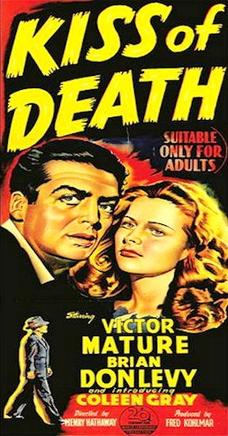
Kiss of Death is a 1947 American film noir directed by Henry Hathaway and written by Ben Hecht and Charles Lederer from a story by Eleazar Lipsky. The story revolves around an ex-con played by Victor Mature and his former partner-in-crime, Tommy Udo. The movie also starred Brian Donlevy and introduced Coleen Gray in her first billed role. The film has received critical praise since its release, with two Academy Award nominations.

Fourteen Hours is a 1951 American drama directed by Henry Hathaway, which tells the story of a New York City police officer trying to stop a despondent man from jumping to his death from the 15th floor of a hotel.
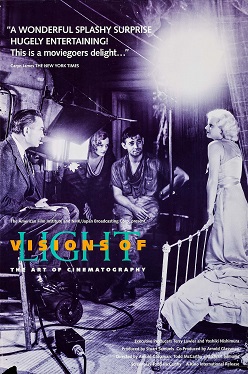
Visions of Light is a 1992 documentary film directed by Arnold Glassman, Todd McCarthy and Stuart Samuels. The film covers the art of cinematography since the conception of cinema at the turn of the 20th century. It features numerous filmmakers and cinematographers as interview subjects, presenting their views and discussing the importance of cinematography in the craft of filmmaking.
Henry Hathaway was an American film director and producer. He is best known as a director of Westerns, especially starring Randolph Scott and John Wayne. He directed Gary Cooper in seven films.
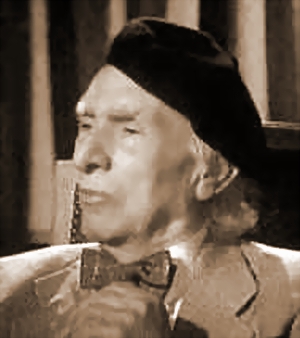
John Alton, born Johann Jacob Altmann, in Sopron, Kingdom of Hungary, was an American cinematographer of Hungarian-German origin. Alton photographed some of the most famous films noir of the classic period and won an Academy Award for the cinematography of An American in Paris (1951), becoming the first Hungarian-born person to do so in the cinematography category.
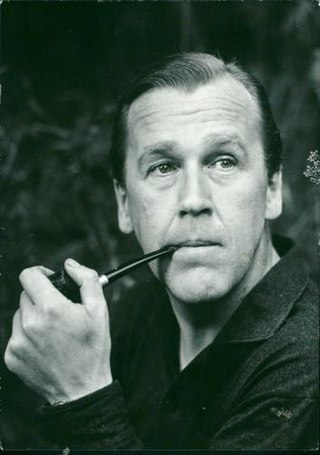
Arne Edvard Sucksdorff was a Swedish film director, considered one of cinema's greatest documentary filmmakers. He was particularly celebrated for his visually poetic and scenic nature documentaries. His works include Pojken i trädet and the Academy Award-winning Människor i Stad.
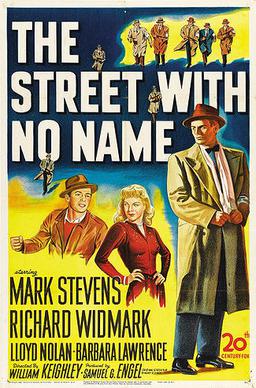
The Street with No Name is a 1948 American film noir directed by William Keighley. A follow-up to The House on 92nd Street (1945), it tells the story of an undercover FBI agent, Gene Cordell, who infiltrates a deadly crime gang. Cordell's superior, FBI Inspector George A. Briggs, also appears in The House on 92nd Street. The film, shot in a semidocumentary style, takes place in the Skid Row section of fictional "Center City."

Paula Raymond was an American model and actress who played the leading lady in numerous movies and television series including Crisis (1950) with Cary Grant. She was the niece of American pulp-magazine editor Farnsworth Wright.

The House on 92nd Street is a 1945 black-and-white American spy film directed by Henry Hathaway. The movie, shot mostly in New York City, was released shortly after the end of World War II. The House on 92nd Street was made with the full cooperation of the Federal Bureau of Investigation (FBI), whose director, J. Edgar Hoover, appears during the introductory montage. The FBI agents shown in Washington, D.C. were played by actual agents. The film's semidocumentary style inspired other films, including The Naked City and Boomerang.
Pulp noir is a subgenre influenced by various "noir" genres, as well as pulp fiction genres; particularly the hard-boiled genres which help give rise to film noir. Pulp noir is marked by its use of classic noir techniques, but with urban influences. Various media include film, illustrations, photographs and videogames.
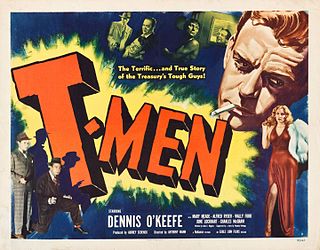
T-Men is a 1947 semidocumentary and police procedural style film noir about United States Treasury agents. The film was directed by Anthony Mann and shot by noted noir cameraman John Alton. The production features Dennis O'Keefe, Mary Meade, Alfred Ryder, Wallace Ford, June Lockhart and Charles McGraw. A year later, director Mann used the film's male lead, Dennis O'Keefe, in Raw Deal.

Steven Geray was a Hungarian-born American film actor who appeared in over 100 films and dozens of television programs. Geray appeared in numerous famed A-pictures, including Alfred Hitchcock's Spellbound (1945) and To Catch a Thief (1955), Joseph L. Mankiewicz's All About Eve (1950), and Howard Hawks' Gentlemen Prefer Blondes (1953). However, it was in film noir that be became a fixture, being cast in over a dozen pictures in the genre. Among them were The Mask of Dimitrios (1944), Gilda (1946), The Unfaithful (1947), In a Lonely Place (1950), and The House on Telegraph Hill (1951).

Phil Karlson was an American film director. Later noted as a film noir specialist, Karlson directed 99 River Street, Kansas City Confidential and Hell's Island, all with actor John Payne, in the early 1950s.
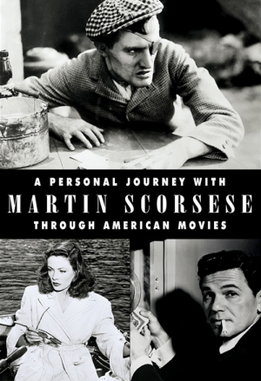
A Personal Journey with Martin Scorsese Through American Movies is a 1995 British documentary film of 225 minutes in length, presented by Martin Scorsese and produced by the British Film Institute.
The Phenix City Story is a 1955 American film noir crime film directed by Phil Karlson for Allied Artists, written by Daniel Mainwaring and Crane Wilbur and starring John McIntire, Richard Kiley, and Kathryn Grant. It had an unusual "triple premiere" held on July 19, 1955 in Phenix City, Alabama, Columbus, Georgia, and Chicago, Illinois.

Reed Hadley was an American film, television and radio actor.

Almira Sessions was an American character actress of stage, screen and television. Born in Washington, D.C., her career took her through all the acting mediums of the 20th century. She appeared in over 500 films and television shows. She worked into her 80s, finally retiring shortly before her death in 1974 in Los Angeles.
The Film Noir Classic Collection is a DVD collection film noir series released by Warner Home Video. Volume 1 was first released in 2004. Two volumes, 2 and 3, were published in 2006. Volume 5 of the series was published on July 13, 2010.
References
- 1 2 3 4 5 6 7 8 9 10 11 Romanski, Philippe; Sy-Wonyu, Aïssatou (2002). Trompe (-)l'oeil: Imitation & Falsification. Publications de l'Université de Rouen. Vol. 324. University of Le Havre Press. p. 343. ISBN 2877753344.
- ↑ 30 Overlooked Noir Films That Are Worth Watching — Taste of Cinema
- ↑ Vice Squad (1953) - Turner Classic Movies
- ↑ DVD Talk review of Kiss Me Deadly: The Criterion Collection
- ↑ Vice Squad (1953) - Turner Classic Movies
- ↑ Vice Squad (1953) - Turner Classic Movies
- ↑ 20 best film noirs: From Double Indemnity to Shadow of a Doubt|The Independent
- ↑ Film Noir: The Semi-Documentaries - by Michael E. Grost
- ↑ McGee, Scott. "The Phenix City Story". WatchTCM. Turner Classic Movies. Retrieved 2021-02-22.
Part semi-documentary, part social problem film, part film noir, Phil Karlson's The Phenix City Story (1955) is a one-of-a-kind window into a sordid and fascinating period in American crime history.
- ↑ Brief Descriptions and Expanded Essays of National Film Registry Titles|Library of Congress
- ↑ Butterflies, beetles, and postwar Japan: semi-documentary in the 1960s: Journal of Japanese and Korean Cinema: Vol.9, No 1
- ↑ A Hard Day's Night movie review (1964)|Roger Ebert
- ↑ Film History of the 1960s
- ↑ The St. Valentine's Day Massacre review (1967)|Roger Ebert
- ↑ NOIR CITY 8: LUST & LARCENY! - ScreenAnarchy
- ↑ 10 great New York noirs|BFI